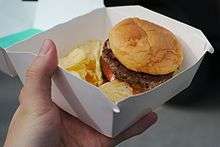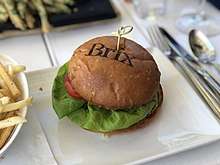Impossible Foods
 | |
| Private | |
| Industry | Food |
| Founded | 2011 |
| Founder | Patrick O. Brown |
| Headquarters | Redwood City, California, US |
| Website | ImpossibleFoods.com |

Impossible Foods Inc. is a company that develops plant-based substitutes for meat and dairy products. Headquartered in Redwood City, California,[1] the company aims to give people the taste and nutritional benefits of meat without the negative health and environmental impacts associated with livestock products.[2] The company researches animal products at the molecular level, then selects specific proteins and nutrients from plants to recreate the experience of meats and dairy products.[2]
Its signature product, the Impossible Burger, was launched in July 2016.
Company and product history
In 2009, Stanford biochemistry professor Patrick O. Brown decided to devote an 18-month sabbatical to eliminating industrial animal agriculture, which he determined at the time to be the world’s largest environmental problem.[3] With other academics, Brown coorganized a conference in 2010 in Washington DC to raise awareness.[4] But the National Research Council workshop called "The Role of Animal Agriculture in a Sustainable 21st Century Global Food System” had minimal impact; soon after, he decided the best way to reduce animal agriculture was to offer a competing product in the free market.[3]
Brown started the company in 2011.[5] In July 2016, Impossible Foods launched its meat analogue product, the Impossible Burger, which is made from material derived from plants.[6] The company says that making it uses 95% less land and 74% less water, and it emits about 87% less greenhouse gas than making a ground beef burger patty from cows.[7] The plant-based burger has more protein, less total fat, no cholesterol and fewer calories than a similar-sized hamburger patty made with beef.[8] It contains more sodium and more saturated fats than an unseasoned beef patty.[9]
Technology
Impossible Foods' scientists discovered that a molecule called heme is a key factor in how meat behaves.[10] Heme is the molecule that gives blood its red color and helps carry oxygen in living organisms.[11] Heme is abundant in animal muscle tissue but is found naturally in all living organisms.[12] Plants, particularly nitrogen-fixing plants and legumes, also contain heme.[13] The heme molecule in plant-based heme is identical to the heme molecule found in meat.[14][15]
To produce heme protein from non-animal sources, Impossible Foods selected the leghemoglobin molecule found naturally in the roots of soy plants.[16] To make plant-based heme in large quantities, Impossible Foods' scientists then genetically engineered a yeast and used a fermentation process very similar to the brewing process used to make some types of beer.[17]
In 2014, Impossible Foods obtained a Generally Recognized As Safe (GRAS) designation for the leghemoglobin in the company's flagship product.[18] In addition, the U.S. Food and Drug Administration issued a “no questions” letter in July 2018, accepting the unanimous conclusion of a panel of food-safety experts that the protein that carries the heme is safe to eat.[19]
The company said that its scientists created a chemical library of proteins and fats derived from plants, and experimented with them as additional ingredients to mimic the texture of meat.[20] To replicate the fat in hamburgers made from cows, Impossible Foods used flecks of coconut fat, which were mixed with ground textured wheat and potato protein. The potato protein provided a firm exterior when the "meat" is seared.[21] The coconut oil stayed solid until heated, when it melted in a similar manner to beef fat.[22]
Production and availability

In 2016 and 2017, Impossible Foods produced Impossible Burgers in relatively small quantities in Redwood City, California and at Rutgers, New Jersey[23] and were not available in retail locations.[24] Impossible Foods also worked on plant-based products that emulate chicken, pork, fish and dairy[25] but initially decided to concentrate on the ground beef used in burgers.[26]
The restaurant Momofuku Nishi in New York, owned by David Chang, began serving the Impossible Burger in July 2016.[27] In October 2016, the Impossible Burger became a standing menu item in selected additional restaurants in California[28] such as Jardinière and Cockscomb in San Francisco, and Crossroads Kitchen in Los Angeles.[29] The Michelin-starred restaurant PUBLIC, operated by Brad Farmerie, began serving the Impossible Burger in January 2017.[30]
In March 2017, Impossible Foods announced it would build its first large-scale plant in Oakland, California to produce one million pounds of plant based burger meat a month.[28] In the first half of 2017, the Impossible Burger debuted on the menu of multi-unit franchises including Bareburger in New York City,[31] Umami Burger in California[32] and Hopdoddy in Texas.[33]
White Castle started serving Impossible Burgers in April 2018. The partnership later expanded to include all 377 of its locations.[34] By July 2018, two years after its initial launch in New York, the Impossible Burger was available in about 3,000 restaurants in the United States and Hong Kong.[35]
Financing
Impossible Foods has raised rounds of $75 million and $108 million from investors including Google Ventures, Khosla Ventures, Viking Global Investors, UBS,[36] Hong Kong billionaire Li Ka-shing's Horizons Ventures and Bill Gates.[37] It was reported that Brown had turned down an offer of $300 million to buy out Impossible Foods in 2015.[26][38]
In August 2017, $75 million in additional financing was raised after reaching key objectives,[39][40] with Bill Gates investing additional money.[41]
In April 2018, an additional $114 million was raised, led by Singapore’s Temasek Holdings and Hong Kong-based Sailing Capital, bringing the total to $372 million, nearly $400 million.[42]
See Also
References
- ↑ "Impossible Foods". Crunch Base. Retrieved 12 August 2015.
- 1 2 "Impossible Foods". Impossible Foods. Retrieved 2015-07-29.
- 1 2 "The Biography of a Plant-Based Burger: One man's mission to make meat obsolete". 2016-09-06.
- ↑ "The Role of Animal Agriculture in a Sustainable 21 st Century Global Food System: A Scoping Workshop" (PDF). dels.nas.edu.
- ↑ Loizos, Connie. "Impossible Foods Raises a Whopping $108 Million For Its Plant-Based Burgers". TechCrunch. Retrieved 2015-10-07.
- ↑ Mic. "The Veggie Burger of the Future Cost $80M to Invent — And Carnivores Will Be Impressed".
- ↑ "Sandwich of the Week, USA Today". 2016-09-06.
- ↑ Hoshaw, Lindsey (June 21, 2016). "Silicon Valley's Bloody Plant Burger Smells, Tastes And Sizzles Like Meat". NPR. Retrieved 2016-07-28.
- ↑ Lemonier, Gabrielle. "Great-Tasting Veggie Burgers are Here, But Are They Any Healthier?". Men's Journal. Retrieved 2017-04-18.
- ↑ "The Justice". 2016-09-29.
- ↑ "The majority of oxygen in the body is transported by hemoglobin, which is found inside red blood cells".
- ↑ Hamza, I; Dailey, HA. "One ring to rule them all: Trafficking of heme and heme synthesis intermediates in the metazoans". Biochim Biophys Acta. 1823: 1617–32. doi:10.1016/j.bbamcr.2012.04.009. PMC 3412874. PMID 22575458.
- ↑ "This New Veggie Burger Bleeds Like Meat".
- ↑ "Serving up a bloody veggie burger is the trick to convincing carnivores". Inverse.
- ↑ "Myoglobin".
- ↑ "Silicon Valley's Bloody Plant Burger Smells, Tastes And Sizzles Like Meat".
- ↑ "A veggie burger that 'bleeds' might convince some carnivores to eat green". Public Radio International "The World". 2016-09-23.
- ↑ "GRAS Notification for Soybean Leghemoglobin Protein Derived from Pichia pastoris" (PDF).
- ↑ "Key ingredient in 'Impossible Burger' approved by FDA". CNBC. 2018-07-24.
- ↑ Fellet, Melissae (13 October 2015). "A Fresh Take on Fake Meat". ACS Central Science. 1 (7): 347–349. doi:10.1021/acscentsci.5b00307.

- ↑ "Welcome to the Era of Plant-Based Meat". Food&Wine. 2016-04-16.
- ↑ "All about the Impossible Burger". 2016-09-12.
- ↑ Wang, Ucilia (2017-03-02). "Can Impossible Foods and its plant burgers take on the meat industry?". The Guardian. ISSN 0261-3077. Retrieved 2017-04-18.
- ↑ "There's a secret ingredient in the plant-based meat Google wanted to buy for $200 million". Tech Insider. 2016-07-19.
- ↑ "Bleeding veggie burgers hit restaurants for first time". The Memo. 2016-07-27.
- 1 2 Rufford, Nick (2017-04-16). "Can the Impossible burger save the world?". The Times. Retrieved 2017-04-18. (Subscription required (help)).
- ↑ "David Chang Adds Plant Based 'Impossible Burger' to Nishi Menu". 2016-07-26.
- 1 2 Robinson, Melia (2017-03-22). "A startup selling 'bloody' plant-based burgers has a new factory that can make 4 million burgers a month". Business Insider. Retrieved 2017-04-18.
- ↑ "The Impossible Burger's West Coast Debut and the Wild Frontier of Plant-Based Meat". Forbes. 2016-10-13.
- ↑ "We Tried a Michelin Star Version of Silicon Valley's Plant Burger That Bleeds Like Beef". 1 February 2017.
- ↑ Rainey, Clint. "The Vegan Burger That 'Bleeds' Goes Mainstream at Bareburger".
- ↑ Pierson, David. "Umami says its new veggie burger tastes like meat — and bleeds like meat". latimes.com.
- ↑ "You can now get Impossible Burger's".
- ↑ Devenyns, Jessi (13 September 2018). "Impossible Burger goes to White Castle". Food Dive. Industry Dive. Retrieved 14 September 2018.
- ↑ "A Major Victory for the Impossible Burger, the Veggie 'Meat' that Bleeds". Wired. 2018-07-24.
- ↑ "Forget Lab Beef, Impossible Foods' 100% Plant-Based Cheeseburger Is Our Future". Motherboard. Retrieved 2015-10-07.
- ↑ Katie Fehrenbacher (2014-10-08). "Meet Impossible Foods, another VC-backed veggie meat startup". Gigaom. Retrieved 2015-07-29.
- ↑ Clements, Lana (2015-07-28). "Google tries to buy vegetarian burger business". Express. Retrieved 2017-04-18.
- ↑ "Impossible Foods Closes a $75 Million Investment After Achieving Key Milestones".
- ↑ "Plant-Based Impossible Foods Raises Another $75 Million: Bill Gates Invests Again".
- ↑ "Impossible Foods closes $75M funding round". www.meatpoultry.com.
- ↑ "Temasek co-leads $114m investment in Asia-bound Impossible Foods".
External links
| Wikimedia Commons has media related to Impossible Burger. |